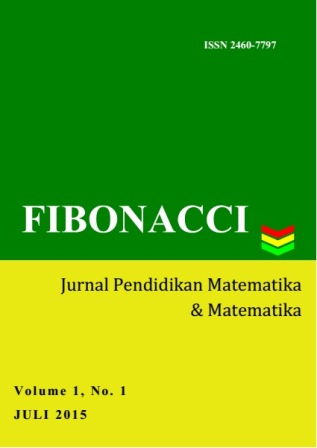PEMAHAMAN SISWA TUNANETRA (BUTA TOTAL SEJAK LAHIR DAN SEJAK WAKTU TERTENTU) TERHADAP BANGUN DATAR SEGITIGA
DOI:
https://doi.org/10.24853/fbc.1.1.15-27Abstract
Bagi seorang tunanetra yang memiliki keterbatasan atau bahkan ketidakmampuan untuk melihat, dalam memahami suatu bangun, mereka akan mengobservasi bangun tersebut dengan menggunakan indera peraba terlebih dahulu dan kemudian menggabungkan gambaran atau refleksi tersebut sehingga konsep mengenai objek tersebut terbentuk. Tujuan dari penelitian ini adalah untuk mengetahui bagaimana pemahamaman siswa tunanetra (buta total) sejak lahir dan sejak waktu tertentu terhadap bangun datar segitiga serta bagaimana perbedaan pemahaman mereka. Subjek dalam penelitian ini adalah dua siswa tunanetra kelas 8 SMPLB-A dimana salah satunya mengalami buta total sejak lahir sedangkan yang lain mengalami buta total sejak kelas 5 SD. Hasil yang diperoleh, kedua subjek memberikan definisi, karakteristik, serta jenis segitiga berdasarkan refleksi pemahaman mereka masing-masing serta pengalaman yang telah mereka dapat. Sehingga dapat dikatakan bahwa usia kebutaan ikut berpengaruh dalam pemahaman serta pembentukan konsep suatu materi. Berdasarkan hasil tersebut dapat digunakan sebagai gambaran dalam mempersiapkan metode serta media/alat pembelajaran bagi siswa tunanetra.References
Campbell, J.J. 2006. “Early language experience: learning from young children who are
blind”. Doctoral Dissertation, University of Western Sydney, College of Arts,
School of Psychology.
Dick, T. and Kubiak, E. 1997. “Issues and aids for teaching mathematics to the blind”.
Mathematics Teacher. Vol. 90, hal: 344-349.
Efendi, M. 2006. Pengantar Psikopedagogik Anak Berkelainan. Jakarta: Bumi Aksara.
Erin, J.N. and Koenig, A.J. 1997. “The Student with a Visual Disability and a Learning
Disability”. Journal of Learning Disabilities. Vol. 30 (3), hal: 309-320.
Hallahan, D.P. and Kauffman, J.M. 1991. Exceptional children - Introduction to special
education. Virginia: Prentice-hall International, Inc.
Hatton, D.D., Bailey, D.B., Burchinal, M., and Ferrell, K.A. 1997. “Developmental
growth curves of preschool children with vision impairments”. Child
Development. Vol. 68 (5), hal: 788-806.
Hiebert, J. 1986. Conceptual and procedural knowledge: the case of mathematics.
Hillsdale, NJ: L. Erlbaum Associates.
Hudojo, H. 1998. Mengajar Belajar Matematika. Jakarta: Direktorat Pendidikan dan
Kebudayaan, Direktorat Jendral Pendidikan Tinggi, Proyek Pengembangan
Lembaga Pendidikan, Tenaga Kependidikan.
Lechelt, E.C. and Hall, D.L. 1999. The Impact of Vision Loss on the Development of
Children From Birth to 12 Years: A Literature Review. The Canadian National
Institute for the Blind.
Lowendfeld, B. 1973. The visually handicapped child in school. New York: The John
Day Company.
Moerdiani, S. 1987. Psikologi anak luar biasa. Bandung: Universitas Islam Nusantara.
Suhartini, A. 2007. “Belajar Tuntas: Latar Belakang, Tujuan, dan Implikasi”. Lentera
Pendidikan. Edisi 10, No. 1, hal: 8.
Susanto. 2008. “Proses berpikir anak tunenetra dalam menyelesaikan masalah
matematika”. Disertasi Doktoral, UNESA.
Warren, D.H. and Rossano, M.J. 1991. “Intermodality relations: vision and touch”. In
M. A. Heller and W. Schiff (Eds). Psychology of Touch, 119-137. New Jersey:
Lawrence Erlbaum Associates.
Wirasto. 1987. “Beberapa Penyebab Kemerosotan Pendidikan Matematika di Negara
Kita”. Makalah disampaikan pada Seminar Nasional Pendidikan Matematika di
IKIP Sanata Dharma Yogyakarta.
Downloads
Published
Issue
Section
License
Authors who publish with this journal agree to the following terms:
- Authors retain copyright and grant the journal right of first publication with the work simultaneously licensed under a Creative Commons Attribution License that allows others to share the work with an acknowledgement of the work's authorship and initial publication in this journal.
- Authors are able to enter into separate, additional contractual arrangements for the non-exclusive distribution of the journal's published version of the work (e.g., post it to an institutional repository or publish it in a book), with an acknowledgement of its initial publication in this journal.
- Authors are permitted and encouraged to post their work online (e.g., in institutional repositories or on their website) prior to and during the submission process, as it can lead to productive exchanges, as well as earlier and greater citation of published work (See The Effect of Open Access).

